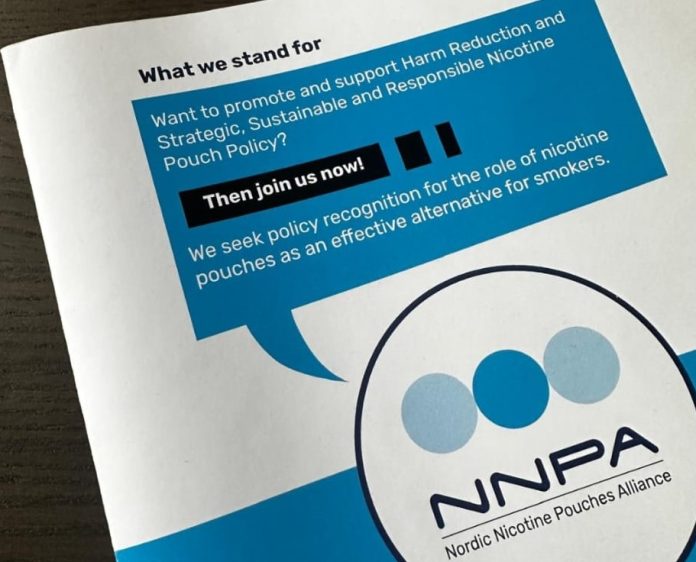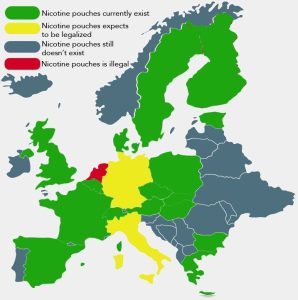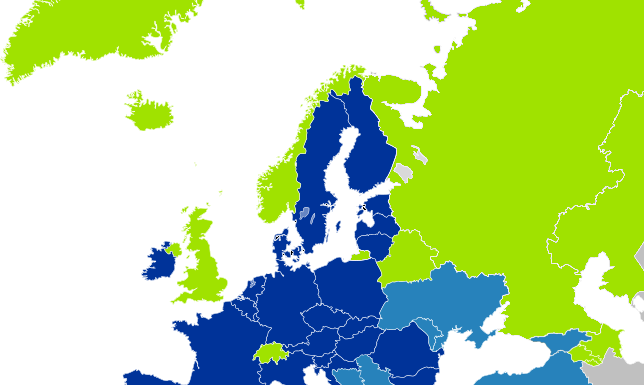By Jonas Lundqvist (CEO NNPA.EU) and Robert Casinge (NNPA / Editor in Chief Pouchforum)
The NNPA is aiming to break new ground with its call to action —a responsible value chain for nicotine pouches, a comprehensive proposal outlining a vision for future EU legislation, for the first time presented from the main stage at the EVO NXT fair in Malaga and today on World No Tobacco Day 2024 we are for the first time presenting our vision to legislators, the public and everyone outside of the value chain. The document is meant to represent a lowest common denominator for responsible producers, distributors and other members of the nicotine pouch value chain while challenging preconceived notions about the industry by advocating for stringent measures that protect under-age consumers, enforce clear labelling, engage in responsible marketing, and establish a maximum nicotine content threshold. More specifically, our ‘What we stand for’ manifesto details a series of proposed outlines for EU law and does not suggest self-imposed industry standards. In this article we will describe both the background of how we reached this point and why we have decided to take on a leading role instead of just speaking on our own behalf. We believe this is both an unprecedented move and a common way forward for the nicotine pouch community. We want to enhance the constructive dialogue with EU legislators and to ensure that the whole value chain can be heard and considered in the EU decision making process given its strong expertise on every single one of the various challenges we will face when regulating nicotine pouches. In view of the upcoming EU Election and change of the EU Leadership this is the time to consolidate the position of the industry and present a valid legislative alternative that takes on a holistic approach and integrating both challenges and possibilities.
The Nordic Nicotine Pouches Alliance (NNPA.eu) is a Brussels-based stakeholder platform, born from a long-standing experience with oral nicotine consumption and EU legislation. A few years ago, it was clear to us that nicotine pouches, that are out of scope of present EU law, would be the next big legislative challenge in this sector. This greatly reduced risk product that also is very customizable, requires no investment for consumers, can be used without inconveniencing others, and has an obvious appeal for any smoker looking for an alternative. To us it was also a possibility to build on the Swedish success story where a traditional use of oral tobacco led through innovation and development to the consumer-driven shift of the nicotine market we see today. People in Sweden opt to use the readily available alternatives to smoking and the age bracket below 29 years of age has therefore been below the 5% threshold (to be considered smoke free according to WHO) since 2018. Today the average smoking rate for the population aged between 16-45 is 4% while the same development in all other EU member states was made impossible by the EU ban on snus in 1992. Now, 80 million smokers all over Europe have been given a new chance: the nicotine pouch. Considering the figures for the rest of the EU, where some countries see an increase of smoking in the same age brackets and in the light of the targets set out by the Commission for a smoke free Europe 2040, reduced risk products should be welcomed with open arms. Instead, we see a change of direction where the risk is no longer the core criteria guiding policy and the new focus is to oppose nicotine use regardless of risk, even if a simple extrapolation of the Swedish data shows a massive potential for improvement of public health.
The NNPA has been navigating the evolving landscape of tobacco control legislation since 2021, working to ensure that the significance of harm reduction in nicotine consumption is understood and emphasized. We have met hundreds of stakeholders, legislators, producers and retailers and we perceive a common vision of larger goals such as the mission on beating cancer, to limit causes for non-communicable diseases, while protecting the underage group and to encourage people to make better choices by creating incentives, providing possibilities or in other ways assisting change and improvements. However, the same landscape presents a visible threat. There is a lack of knowledge about the product among policy makers and legislators at EU-level. There are numerous unfounded allegations about nicotine pouches being a gateway to smoking even if empirical data from the Nordic countries suggest the opposite. There are however real issues that should be addressed such as pouches with extreme amounts of nicotine branded in a way that creates a clear risk for underage appeal. The latter challenges have a potential to overshadow the possibilities and create a “perfect storm” that could threaten the future of nicotine pouches with unwarranted over regulation on a factually incorrect foundation.
Challenging misconceptions
When discussing nicotine pouches in the public domain we discovered that the previously mentioned goals, along with facts and statistics, seem to have little or no weight compared to preconceived notions or the need to show that forceful measures are taken against nicotine, no matter the actual outcome. We have also seen countless examples of severe misrepresentation of the product category in the media. Nicotine pouches are described in terms like “contains up to 100mg of nicotine per pouch” which might be true if looking at an extreme fringe product with a non-existent market share, while products below 18 mg per pouch represent approximately 90% of the market. The category is regularly being accused of contributing to various hidden agendas ranging from unsubstantiated general claims to pure defamation. Most producers already follow currently regulations existing in most member states, that have regulated the product in one way or the other. We therefore intend to engage with policymakers and legislators to contribute to a sustainable and safe market for Nicotine Pouches in Europe. The NNPA is not only an advocate for responsible legislation of nicotine pouches in general, we also have concrete proposals such as a focus on prohibiting sales to underage individuals, introducing retail licensing schemes, and prioritizing supervision of the retail trade.
We want to show what is representative for the industry and what it would actually want to see as an outline for future legislation. The first step is to find a common ground for the discussion. This will be a challenge in itself. The mere fact that nicotine pouches are not risk-free, even if commonly accepted as highly reduced risk compared to smoking cigarettes, means that it is better from a risk perspective to not use them at all, just like it is better to not take other moderate risks such as drinking coffee, soda and alcohol or use most non-prescription medicines. The fact that, regardless of decades of anti-smoking campaigns and cessation policies, there are still around 80 million daily smokers in the EU, is simply not accepted as a valid criterion. We consider this negligent, and to give the benefit of the doubt that it is done with good intentions, misguided. To encourage leaving the trenches and finding a common ground for discussion while maximizing the effect for public health, we present our manifesto with five major points, that we during the last few years have come to understand have an overwhelming support by the industry:
Embracing Alternatives
The example from countries like Norway and Sweden, with a smoking prevalence close to 1/5 of the average smoking prevalence in the EU, has demonstrated the effectiveness of oral nicotine products in reducing smoking rates. Sweden’s incidence of cancer is 41% lower than the rest of its European counterparts, corresponding to a 38% lower level of total cancer deaths. 24 of the other 27 EU Member States have a tobacco-related mortality rate twice as high as Sweden, relative to population size. Sweden has a 39.6% lower rate of death of all tobacco-related diseases compared to the EU average and has the lowest number of deaths attributed to lung cancer. While acknowledging that no nicotine product is entirely risk free, we must embrace effective alternatives and accept that traditional approaches to tobacco control, that demand complete nicotine abstinence, have proven ineffective for a significant part of the smoking population. These indications are not marginal or minor. The ban on snus has provided us with a country-sized and several decades-long experiment and the results should be taken into account for all legislation on nicotine pouches.
Underage Access Prevention
No underage individuals should use any nicotine products. To address concerns about underage access, NNPA advocates for targeted legislation that preserves access to nicotine pouches for adults while preventing underage access. Clear guidelines and adequate resources must be provided to competent authorities for effective supervision and enforcement. The review of the current -EU legislation must find the ideal balance between shielding young people from nicotine dependency and providing reduced-risk alternatives for adult smokers. The primary line of defense against underage consumption lies in strict and consistent enforcement of minimum age limits for the purchase, possession, and consumption of all nicotine-containing products.
We propose the same age limits and licensing (where viable) should apply for nicotine pouches as for cigarettes, even if they present a significantly lower risk. On top of this we suggest increased supervision of retailers as well as penalties for adults providing nicotine to anyone below age.
Rethinking Flavor Bans: Alternative regulatory options to address the real issue of preventing youth appeal.
Flavors are integral to the acceptance of nicotine pouches among adult smokers, but no product should be perceived as marketed towards an underage target group. Oral-use products without flavor risk facing complete rejection from consumers since there is no natural flavor in tobacco-free pouches. This is an acute challenge since defining “flavors” as such is almost impossible from a regulatory perspective. We consider that a more effective approach would be to restrict the communication and certain references on packaging and in marketing. Marketing nicotine products as “bubble gum flavor” significantly differs from providing pouches with the taste of fruit and should not be allowed.
Ensure product safety and acknowledge consumers’ preferences.
To maintain the appeal of nicotine pouches as an alternative to smoking, it is crucial to provide adequate nicotine levels while upholding consumer safety. The NNPA supports clear labelling of nicotine content and advocates for a maximum nicotine level per pouch of 20 milligrams to maintain effectiveness while ensuring user safety. The conclusions that were reached by the German Federal Institute for Risk Assessment (BfR) in its recent report “Health Assessment of Nicotine Pouches” (October 7, 2022) are scientifically well argued. According to technical specifications outlined by the Swedish Institute for Standards (SIS), it is recommended that nicotine pouches should not exceed 20 milligrams of nicotine per consumable. In response to these standards, several countries have implemented limits, capping nicotine concentration at, or close to 20 milligrams per pouch. This level should be sufficient to provide even very seasoned smokers enough nicotine if they decide to make a switch while excluding extreme products from the market.
Incentivizing Change:
Finally, we strongly believe that excise policies should encourage smokers to transition to potentially less harmful alternatives, such as nicotine pouches, without deterring their use. NNPA supports simple and efficient tax regimes with moderate tax level that acknowledge the reduced harm of nicotine pouches compared to cigarettes, proposing excise rates on nicotine pouches that are substantially lower than those applied to cigarettes.
The response we have met from the value chain when discussing these proposals is close to unanimous and almost always very positive. Both producers and retailers have told us that they have been waiting for a clear and responsible regulatory framework. This is what we want and how we want to achieve it. Our alternative is a blueprint for pinpointing basically every major issue that has been brought up against nicotine pouches and while hoping this will take the public discussion to a new level, we are impatiently waiting to bring this message to every single legislator and to hear their concerns.
Disclaimer: www.BrusselsReport.eu will under no circumstance be held legally responsible or liable for the content of any article appearing on the website, as only the author of an article is legally responsible for that, also in accordance with the terms of use.














